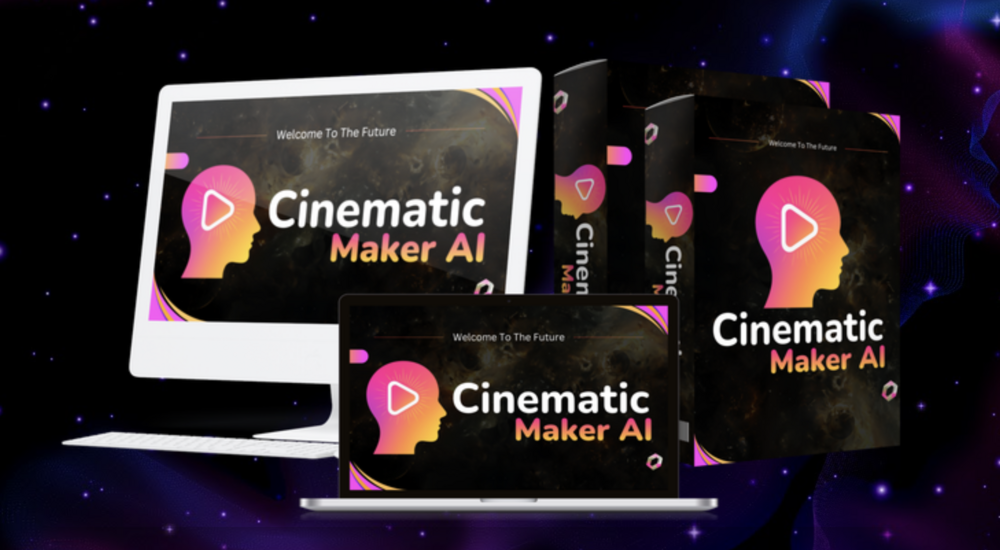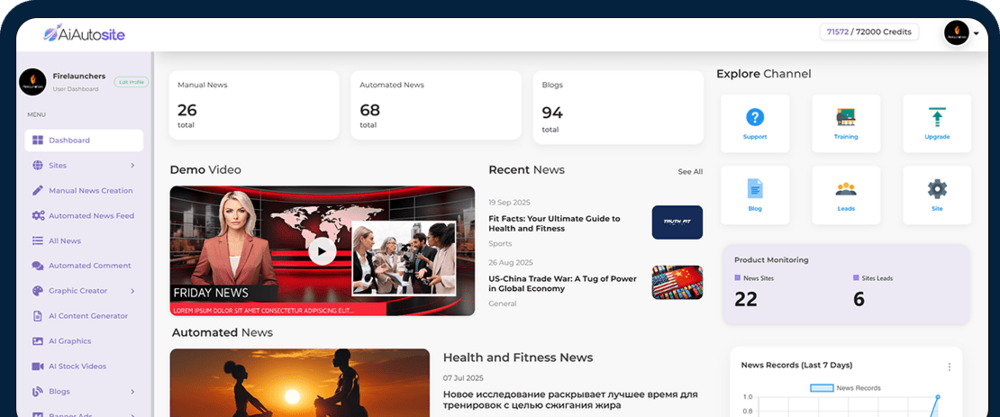
Cinematic Maker AI Review: I Tried it (My Experience)
The Filmmaker Who Never Picked Up a Camera
When Sam was a kid, he dreamed of making movies. Not just any movies—he imagined sweeping battle scenes, fire-breathing dragons, sci-fi space wars, and slow-motion hero moments. But life happened. Cameras were expensive, editing software was intimidating, and hiring actors or renting sets? Out of the question.
Fast forward to today, and Sam sits at his desk, typing a short sentence into a box:
“A knight standing on a mountain, lightning crashing behind him, sword raised high.”
Within minutes, his screen flickers with something magical. A cinematic trailer sequence in full 4K, complete with dramatic background music and narration, materializes before his eyes.
No actors. No cameras. No studio. Just a platform called Cinematic Maker AI.
And that’s the promise we’re reviewing today: a tool that claims to put the power of Hollywood-style filmmaking into your laptop browser. But is it truly groundbreaking, or just another overhyped AI gimmick? Let’s dive deep.
👉 Get Cinematic Maker AI at a Discount Price
What Is Cinematic Maker AI?
Cinematic Maker AI is a cloud-based video creation platform designed to generate cinematic videos, trailers, and short films using nothing more than text prompts and simple settings.
Unlike traditional editors where you drag clips and splice footage, here you describe what you want—and the AI handles the production. Think of it as a director who never sleeps: you feed it the script, and it brings the scene to life.
Core Claims:
-
Create cinematic-quality videos in 4K or even 8K
-
No cameras, actors, or editing software required
-
AI-driven special effects (explosions, lightning, fire, etc.)
-
Voiceover and soundtrack options built-in
-
Scenes built from text prompts and visual direction
The creators pitch this as a revolution for:
-
Content creators who want scroll-stopping visuals
-
Marketers needing promo trailers without studio costs
-
Storytellers or indie filmmakers prototyping ideas
-
Agencies selling cinematic ad spots
On paper, it sounds like the biggest leap forward in DIY video making we’ve seen yet.
Features & Capabilities
Cinematic Maker AI is packed with tools. Let’s break them down.
Prompt-to-Video Engine
The crown jewel. Enter a description—like “a spaceship entering hyperspace with sparks flying”—and the system generates a scene. AI interprets mood, composition, and visual style to make it look cinematic.
Genre & VFX Library
You can tailor your video by selecting cinematic genres: sci-fi, fantasy, action, mystery, documentary. Then layer VFX like:
-
Fire explosions
-
Lightning strikes
-
Fog/mist for atmosphere
-
Particle effects for sci-fi glow
This instantly adds flair without needing After Effects expertise.
Voiceovers & Narration
With 150+ voices in multiple languages, you can turn scripts into professional narrations. Think movie-trailer-style deep voices, soft documentary narrators, or energetic social media voiceovers.
Soundtrack Composer
The AI generates soundscapes—dramatic orchestral music for a trailer, eerie sound beds for a horror scene, upbeat scores for marketing promos. Music syncs with scenes automatically.
Scene Builder & Editing Interface
Beyond raw prompts, Cinematic Maker AI provides a drag-and-drop interface to:
-
Arrange generated scenes into a sequence
-
Add transitions between shots
-
Control pacing and timing
-
Insert titles, logos, and end credits
Resolution & Formats
-
Output in 4K or 8K
-
Aspect ratios: horizontal (16:9 for YouTube), square (1:1 for Instagram), vertical (9:16 for TikTok/Reels)
Commercial License
Some packages include commercial rights—meaning you can sell the videos to clients or use them in ads without extra royalties.
Workflow: How It Actually Feels to Use
I tested Cinematic Maker AI with a short “fantasy battle trailer.” Here’s how the workflow went.
-
Prompt Input
Typed: “Epic medieval battlefield, thousands of soldiers clashing under stormy skies, cinematic lighting.” -
Select Genre & VFX
Chose “Fantasy,” added lightning effects. -
Voiceover & Music
Typed script: “In a land torn by war, one hero will rise.” Selected a deep, gravelly English narrator. Chose “epic orchestral soundtrack.” -
Render & Review
In under 10 minutes, a 45-second clip was ready. The AI matched visuals to my script, layered narration, and timed music crescendos with battle visuals. -
Edit & Export
I trimmed a few seconds, added a title card, and exported in 4K.
Verdict on workflow: shockingly smooth. While not every shot looked perfect (a few character faces were uncanny), the overall flow felt like a professional trailer.
👉 Get Cinematic Maker AI at a Discount Price
Use Cases & Real-World Applications
Content Creators & Influencers
-
Instagram reels with dramatic flair
-
TikTok storytelling in cinematic style
-
YouTube intros/trailers
Marketers & Agencies
-
Quick promo spots for clients
-
Ad campaigns with Hollywood-style impact
-
Product launches with cinematic trailers
Storytellers & Indie Filmmakers
-
Concept prototyping (visualize scripts before funding)
-
Pitch decks for investors using cinematic mood reels
-
Animatics without animation teams
Educators & Trainers
-
Make engaging course intros
-
History or science explained with cinematic visuals
-
Student projects made memorable
Strengths vs Trade-offs
Strengths
-
Accessibility: no filmmaking skills required
-
Speed: minutes vs weeks of editing
-
Variety: genres, VFX, voiceovers, music—all in one platform
-
Commercial use: potential revenue from selling videos
-
Scalability: churn out content at speed for multiple platforms
Trade-offs
-
Quality Variation: some scenes look breathtaking; others slightly uncanny
-
Creative Limits: AI interprets prompts; you may not always get exactly what you imagined
-
Upsells: certain features may be gated behind higher-tier pricing
-
Vendor Dependency: you rely on their cloud platform for rendering
Pricing & Value Analysis
Cinematic Maker AI typically launches with:
-
Front-end license: basic tool access
-
Unlimited/Enterprise upgrades: more scenes, more exports, higher resolutions
-
Template packs: genre-based assets, additional VFX
-
Commercial license: often included in higher tiers
Compared to hiring a video team (thousands of dollars per project), even the higher-tier package pays for itself with just one or two client projects.
👉 Get Cinematic Maker AI at a Discount Price
How It Compares to Competitors
-
Runway AI / Pika Labs: strong video gen, but not tailored for cinematic trailers and storytelling; more raw clips.
-
Synthesia: excellent for talking-head avatar videos, not cinematic action scenes.
-
Adobe After Effects (manual): ultimate control, but requires massive skill/time.
-
Cinematic Maker AI: bridges the gap—targeted at cinematic trailers, storytellers, marketers who want speed and drama.
ROI: When Does It Pay Off?
Let’s run simple math:
-
Suppose you charge $200 for a cinematic trailer.
-
With Cinematic Maker AI, you can deliver 2–3 in a day.
-
Sell 10 per month = $2,000 revenue.
Even if the tool costs a few hundred dollars one-time or annually, ROI is clear if you market aggressively.
Agencies can package AI cinematic content as part of social ad campaigns—and clients pay premium because it looks expensive.
Final Verdict
Cinematic Maker AI isn’t perfect. It won’t replace an Oscar-winning cinematographer, and it won’t capture every detail of a billion-dollar Marvel movie. But for solo creators, marketers, and agencies hungry for cinematic content fast, it’s revolutionary.
It lowers the barrier so anyone can create eye-popping trailers, ads, and story reels—without cameras, crews, or Hollywood budgets.
If you want speed, style, and storytelling power in your pocket, it’s worth testing—especially while the early-bird discount is live.


